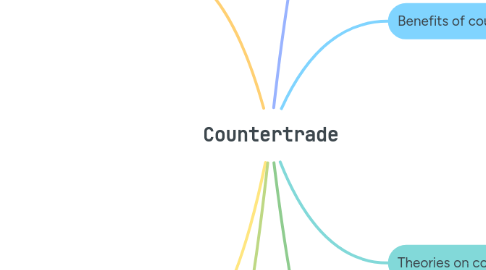
1. Forms of countertrade
1.1. Exchange of goods/services for goods/services
1.1.1. Barter
1.1.1.1. Direct exchange of goods and services between two trading parties
1.1.2. Switch trading
1.1.2.1. An arrangement in which the switch trader will buy or market countertraded goods for hard currency
1.1.3. Clearing arrangement
1.1.3.1. A method in which two governments agree to purchase a certain volume of each other’s goods/services over a given period of time
1.1.3.2. In the event of trade imbalance, settlement could be in hard currency payments, transfer of goods, issuance of a credit or use of switch trading
1.2. Parallel transactions
1.2.1. Buy-back
1.2.1.1. An arrangement in which a private fi rm will sell or license technology to an overseas customer with an agreement to purchase part of the output produced from the use of such technology
1.2.1.2. The agreement involves two contracts, both of which are discharged by payment of hard currency
1.2.2. Counterpurchase
1.2.2.1. Two parallel transactions in which a firm exports a product to an overseas buyer with a promise to purchase from the latter or other parties in the country goods not related to the items exported
1.2.3. Offsets
1.2.3.1. A transaction in which an exporter allows the purchaser, usually a foreign government, to reduce the cost of purchasing the exporter’s product by coproduction, subcontracting, investments and transfers of technology
2. Countertrade and the GATT/WTO
2.1. Countertrade represents a significant departure from the principles of free trade based on comparative advantage.
2.2. Countertrade results in higher transaction costs.
2.3. Countertrade is inconsistent with the national treatment standard which is embodied in most trade agreements
3. Governments’ attitude toward countertrade
3.1. U.S. government prohibits federal agencies from promoting countertrade in their business.
3.2. Adopts a hands-off approach in relation to private transactions.
4. What is countertrade?
4.1. any commercial arrangement in which the exporter is required to accept in partial or total settlement of his/her deliveries
4.2. Barter could be traced to ancient times
4.3. Presently, countertrade is estimated to account for 15–20 % of world trade.
4.4. Key Stakeholders
5. Benefits of countertrade
5.1. Benefits for buyers
5.1.1. Transfer of technology
5.1.2. Alleviation of balance of payments difficulties
5.1.3. Market access and maintenance of stable prices
5.2. Benefits for exporters
5.2.1. Increased sales opportunities
5.2.2. Access to sources of supply
5.2.3. Flexibility in prices
6. Theories on countertrade
6.1. Countertrade is positively correlated with a country’s level of exports
6.2. Countertrade is partly motivated in order to substitute for foreign direct investment.
6.3. The stricter the level of exchange controls, the higher the level of countertrade activity.
7. Offsets
7.1. Direct offsets
7.1.1. Co-production
7.1.1.1. Joint venture or licensing arrangements with overseas customer
7.1.2. Subcontractor production
7.1.2.1. Arrangement for production in the importing country of parts or components of the export product destined to the latter
7.1.3. Investments and transfer of technology
7.1.3.1. Certain offset agreements provide for investments and technology transfer to the importing country
7.2. Indirect offsets
7.2.1. Offset arrangements in which goods and services unrelated to the exports are acquired from or produced in the importing country
